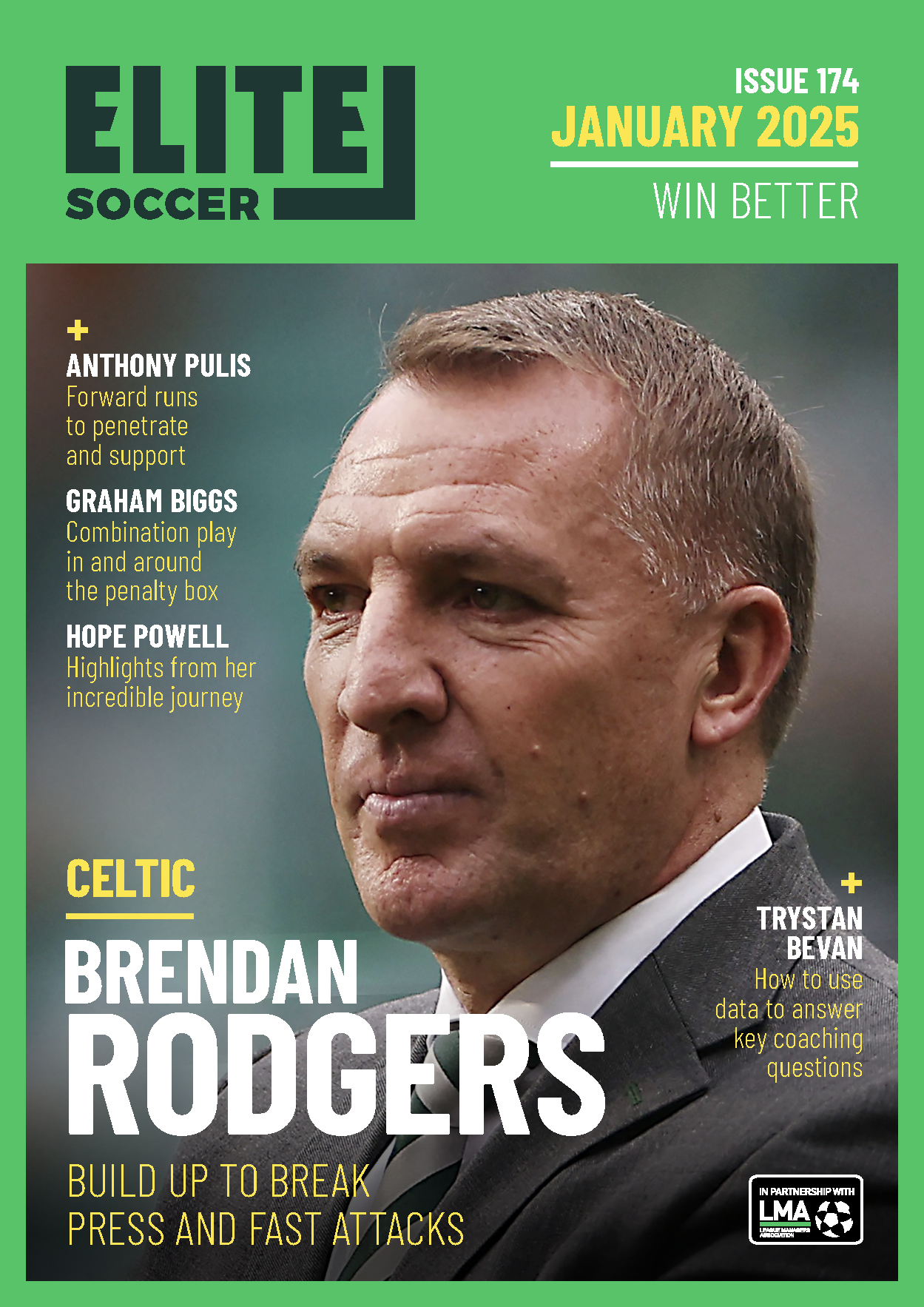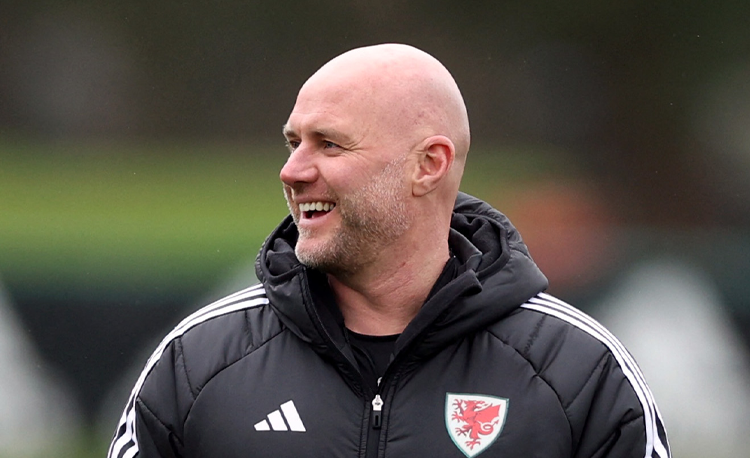You are viewing 1 of your 1 free articles
Possession with penetration
This is a training practice that quickly evolves from a simple passing triangle to other activities that coach pressing, receiving, combinations, switches and team movement.
| Area | Use of a marked pitch |
| Equipment | Balls, cones, goals, mini-goals, poles |
| No. of Players | Full squad |
| Session Time | 60mins |
This is a training practice that quickly evolves from a simple passing triangle to other activities that coach pressing, receiving, combinations, switches and team movement.
It’s great to see players building their understanding as a session develops, and this is exactly the sort of plan that enables them to be ‘game ready’ ahead of a competitive fixture.
What do I get the players to do?
The passing triangle (2x4mins)
We will set up two identical areas (one is shown), with three cones organised in a triangular shape (1), 15 yards apart.
This practice uses simple one-twos before breaking out into a final dribble. On each ‘final’ pass the player follows the ball so that each moves to a new station. When all three players have done a full circuit we will run the practice in the other direction.
1
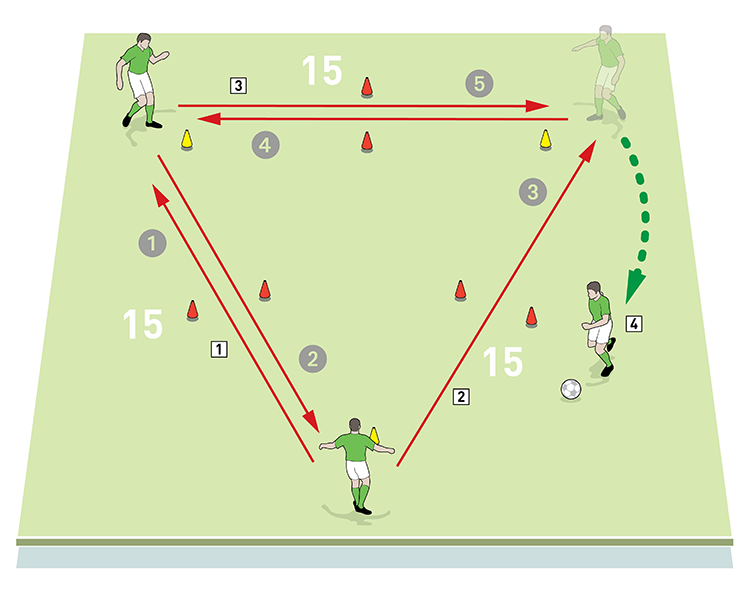
2. Next player A feeds player C
3. Player C plays a one-two with player B
4. Player C now opens up and dribbles to player A
5. All players follow their ‘final’ passes
What are the key things to look out for?
Here, we want to see good technique in passing and receiving, accuracy of the pass and speed of both passes and movement between stations.
Pressing exercise (10mins)
In the next practice we have three defenders passing between each other, as shown (2). To begin with only outside players can pass into the goal, and it is the task of the three attackers to work backwards and forwards in pressing their opponents.
To progress the challenge and make the passages of play less predictable for defenders, we will allow the middle player to pass into the goal.
2
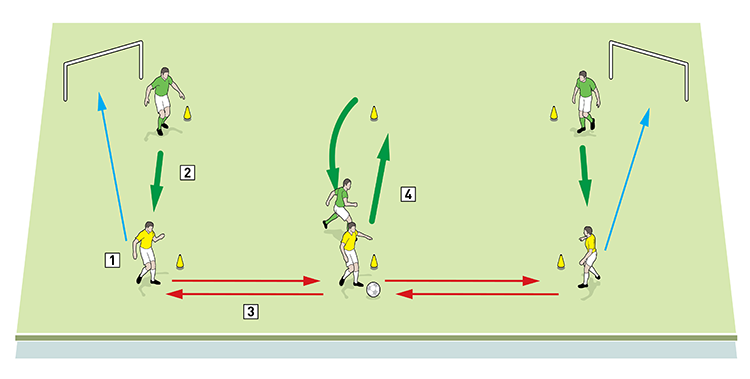
2. Player A steps up to press
3. The ball is then played to player 2
4. Now player B gets up to press
5. After a player has pressed and returned to his position, the next player then comes in to press
What are the key things to look out for?
In this practice we want to see players developing an understanding of pressing and blocking lines of passes. We’re also paying close attention to the speed and angle of the press.
Combinations and sharp movements (12mins)
We now set up, as shown, in a 26x26-yard area with a small gate in each corner (3). This is a 6v6 centrally with the outside ‘gate’ players from each team positioned diagonally in relation to each other. It’s three-touch in the middle and two-touch on the outside.
Players score a point by passing through the gate to their outside player, who will check to the side to receive before quickly ‘bouncing’ the ball back in as his team aims to retain possession.
3

2. The corner player moves off the cone and up the touchline in making a one-two
3. The ball is fed back into the central area with greens retaining possession effectively
What are the key things to look out for?
Here we are working on ball retention, plus angles of passing and receiving, and support around the ball. In addition, we’re paying attention to the second angle a player makes after a pass is dispatched, as well as that player being alert to a ball coming straight back at him.
Gate switch of play possession (15mins)
Now we use a 40x44-yard pitch, with three four-yard gates at each side, as shown (4). This is 8v8 with keepers in place.
Simply, players have to run the ball through a gate for a point, with the keeper needing to position himself behind a gate in order to stop an opponent coming through. If the attacker sees the keeper in place he must switch play and look to set up a team mate for a different opportunity to penetrate.
4
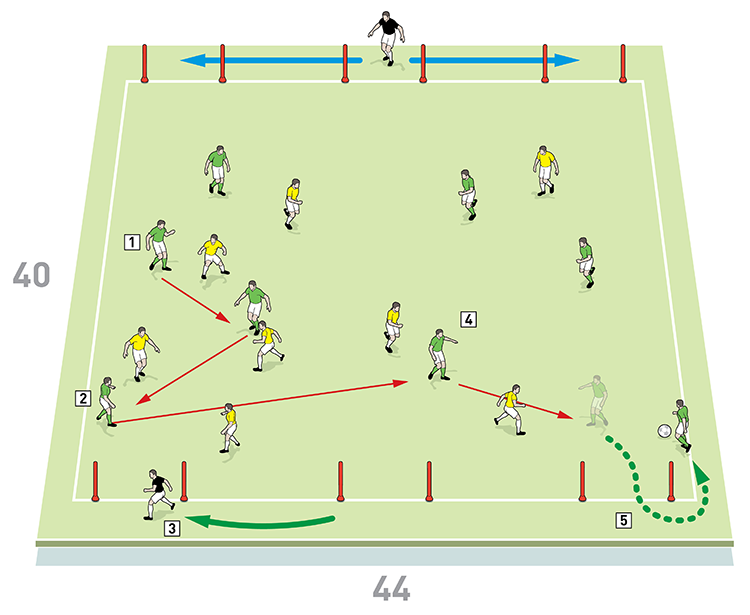
2. Quick passing sees the attacker close to one of the target goals
3. The keeper moves across to block the entrance
4. A quick switch finds another green in space
5. A goal (point) is scored as the ball is run through the poles
What are the key things to look out for?
Here, we are focusing on the tactical aspect of having open positioning, which allows the team to open up and attack effectively.
Halfway line game (15mins)
Finally, we use a half pitch, 44 yards wide, with a halfway line marked. This is 8v8 with players adopting 3-2-3 formations, as shown (5). This game is played out in the normal way, except for the fact players must be in the attacking half for the team’s goal to stand.
5

2. Greens now combine to close in on the yellow goal
3. As the attack reaches its conclusion, green defenders must ensure they are in the attacking half for the goal to stand
What are the key things to look out for?
The conditions laid out encourage the defensive line to keep the team compact and stay close to the attack. This enables players to press better in transition, and subsequently keeps the team’s platform higher up the pitch.
Related Files
Editor's Picks
Using the goalkeeper in build-up play
Pressing principles
Intensive boxes drill with goals
Penetrating the final third
Creating and finishing
My philosophy
Pressing initiation
Compact team movement
Defensive organisation
Coaches' Testimonials

Alan Pardew

Arsène Wenger

Brendan Rodgers

Carlos Carvalhal

José Mourinho

Jürgen Klopp

Pep Guardiola

Roy Hodgson

Sir Alex Ferguson

Steven Gerrard
Coaches' Testimonials

Gerald Kearney, Downtown Las Vegas Soccer Club

Paul Butler, Florida, USA

Rick Shields, Springboro, USA

Tony Green, Pierrefonds Titans, Quebec, Canada
Join the world's leading coaches and managers and discover for yourself one of the best kept secrets in coaching. No other training tool on the planet is written or read by the calibre of names you’ll find in Elite Soccer.
In a recent survey 92% of subscribers said Elite Soccer makes them more confident, 89% said it makes them a more effective coach and 91% said it makes them more inspired.
Get Monthly Inspiration
All the latest techniques and approaches
Since 2010 Elite Soccer has given subscribers exclusive insight into the training ground practices of the world’s best coaches. Published in partnership with the League Managers Association we have unparalleled access to the leading lights in the English leagues, as well as a host of international managers.
Elite Soccer exclusively features sessions written by the coaches themselves. There are no observed sessions and no sessions “in the style of”, just first-hand advice delivered direct to you from the coach.



